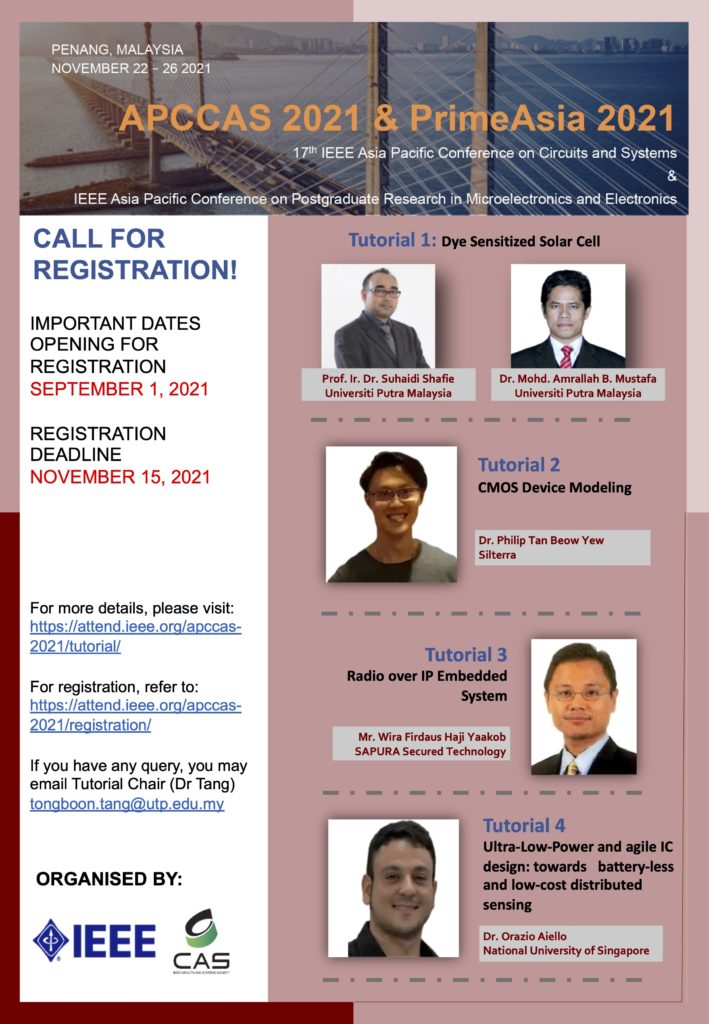
Tutorial

1. Professor Ir. Dr. Suhaidi Shafie 1.

2. Dr. Mohd. Amrallah B. Mustafa
Title: Dye Sensitized Solar Cell Tutorial (by speaker 1 and 2)
Abstract: The tutorial is designed for beginner for the researcher to introduce them to DSSC. The basic construction of DSSCs consists of three main parts ( Dye-sensitized photoelectrode, electrolyte and counter electrode) with a sandwich of two conducting substrates. The use of oxide semiconducting materials such as Tin(II) oxide(SnO), Titanium dioxide (TiO2) or Zinc oxide (ZnO) which act as a scaffold for dye molecules. It also presents the medium for electron charge transfer when the electron reaches its conduction band. However, TiO2 has considered the most used and efficient semiconductor due to its numerous superior characteristics, such as low toxicity, high chemical stability and mesoporous microstructure. After this tutorial, all participants get the knowledge of DSSCs and can fabricate their own DSSCs.

3) Speaker: Dr. Philip Tan Beow Yew
Title: CMOS Device Modeling Tutorial
Abstract: This tutorial is specially design for beginners who intended to have a quick but clear understanding of CMOS SPICE model. It points out the key basic concepts of CMOS SPICE models. Now, you do not need to be an experts who understand most of the physical equations in order to do the basic SPICE model extraction and apply the models for circuit design use. You just need to understand the key equations that will cover the fundamental physical characteristic of today’s deep submicron CMOS transistors. SPICE model extraction is basically to find the appropriate values for the parameters in these physical equations that will give us the accurate electrical behavior that matches to the silicon data. After this tutorial, extracting or modifying a SPICE model file is possible for everyone.

4) Speaker: Mr. Wira Firdaus Haji Yaakob
Title: Radio over IP Embedded System Tutorial
Abstract: Radio over Internet Protocol (RoIP) is an integration of Voice over Internet Protocol (VoIP) with two-way radio control signals such as Push to Talk (PTT) and Carrier Operated Relay (COR) in digital format (audio, video). It provides end to end digital signaling from a handset radio to any other communication devices in the world such as smartphones, PCs, tablets, smartwatches, VoIP and Public Switched Telephone Network (PSTN). RoIP enables connection between different radios of different frequency bands to each other within or beyond Loss of Signal (LOS). Therefore, RoIP enables long distance bidirectional communication between a remote location to any other locations in the world.
This tutorial is specifically aimed for beginners who intended to have a basic understanding of RoIP. It will get you up to speed on the fundamentals of RoIP, the RoIP building blocks and what each does. It also provides understanding of RoIP applications, challenges and implementation. At the end of the tutorial, you will know what are the applications of RoIP and how to apply it in your communication world such as for emergency response. This tutorial is essential for embedded system engineers too. It will help to enhance your knowledge in terms of RoIP systems and their integration with radio networks.

5) Speaker: Dr. Orazio Aiello
Title: Ultra-Low-Power and agile IC design: towards battery-less and low-cost distributed sensing
Abstract: The vision of a world where pervasive integrated electronic systems embedded in everyday life objects (e.g. household appliances, surveillance cameras, healthcare systems) are fully interconnected to collect process, and exchange useful information requires energy-autonomous systems for distributed sensing and data acquisition. The low-cost requirement demands a small area, low design effort, digital-like shrinkage across CMOS generations, and design/technology portability. The possibility to exploit the digital (automated) design flow even for analog building blocks can dramatically reduce the design effort of any system-on-chip that faces the analog signal. In this framework, the tutorial illustrates the concepts and the design flows which enable the implementation of analog functions by true digital circuits. These approaches make the IC design suitable to nanoscale IC technologies in near-threshold and voltage/energy/technology scalability. The final aim is to move toward integrated building block able to operate battery-less but powered by harvested source of energy.
